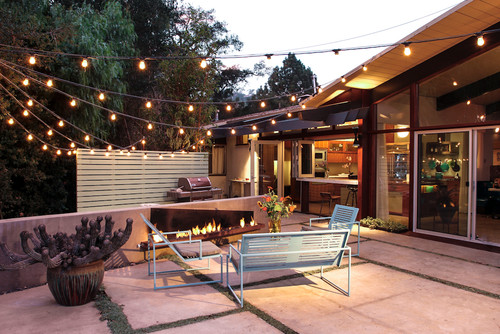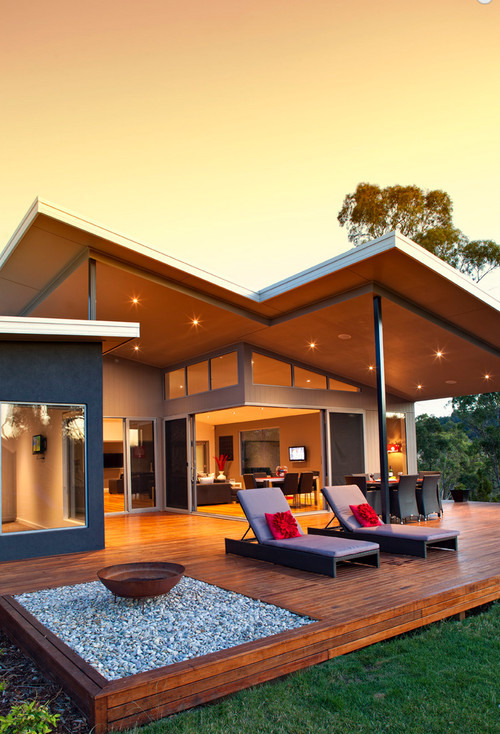I don't know about you, but once the thermometer ticks past 70 degrees, a lightbulb goes off in my head: Is this the year, I ask myself, that I can finally build the outdoor space I deserve?
Of course I can! And so can you. With a little work, you'll soon be grilling in your outdoor kitchen or reading in a hammock on your sunny patio.
But don't drop the ball: There are some elements commonly forgotten during an outdoor renovation that can ruin it all. Go through this list before breaking ground, to ensure your backyard space is up to snuff. And get ready to enjoy the summer!
1. Proper lighting

Photo by Native Son Design Studio
You'd think being able to see at night would be an important patio requirement, but you'd be surprised how often lighting systems are skipped.
"Many homeowners spend time and money creating an outdoor space but forget about this key element," says Joe Raboine, the director of residential hardscapes at Belgard.
Consider first how you intend to use the patio. If you're hoping guests might linger over long conversations, provide low lighting around your seating nooks. And if your backyard BBQ plans involve lots of late-night drinking games (because, why not?), illuminate the entire space with string lights.
2. Electricity
Nothing is worse than planning your perfect patio layout—complete with a keg cooler, botanical garden-worthy lighting, and a show-stopping Christmas display your neighbors will never top—only to realize you forgot one essential element: electricity.
"Be sure to install a few electrical outlets for supplemental holiday lighting or just working on a laptop," says architect and interior designer Leslie Saul.
And no, you can't just add one outlet and be done with it. Will you want speakers? A fridge? A TV? Make sure everything has juice.
3. The position of the sun
Photo by Prime Design Tasmania Pty Ltd
You can't bask in the sun if there is no sun. Before constructing the patio of your dreams, pay close attention to the trajectory of that big ball in the sky.
"The location of the sun relative to an outdoor area is one of the most important elements to consider when designing an outdoor living space," says Shaun Gotterbarn, an architect with Alisberg Parker. "Understanding the sun’s path throughout the day and studying the shadows cast by trees and neighboring buildings allows you to make sure you have your seating area in the perfect place."
4. Outdoor storage

Photo by Harrison's Landscaping
Once temperatures dip, it'll be time to store away all the things that made your outdoor space an enviable destination to begin with. But unless you factored in storage space from the jump, you might find yourself shoving patio cushions into your kids' closets and gardening tools into your pantry.
"Lots of water-resistant outdoor storage allows for a beautiful, clean outdoor space," says patio designer and blogger Eric Clark. "You need multiple easily accessible areas to store outdoor cushions and throw pillows and protect them from rain and mildew."
Or, build your storage into your patio design. If you're adding an outdoor kitchen, leave plenty of cabinet space for your outdoor must-haves, or construct custom cabinetry that blends seamlessly with your siding.
5. Drainage
Here's a shocking secret: Your patio is outside. Where it rains. And rain loves to wreak havoc.
"When rainwater pools on your foundation, you’ll find yourself not only dealing with a safety hazard, but also eventually, you’ll need to redo the entire groundwork," says Robert Himmaugh, manager of Acadian Windows & Siding.
Prevent damage by installing a gutter around your patio roof—if it has a roof, of course—and by paying attention to drainage. Your patio should slope away from your home's foundation, and the ground should slope away from your patio base, as well.
6. Privacy and noise

Photo by Wolf Design Studio
Plan on throwing raucous parties in your new outdoor space? Good for you—unless you've built it right next to your neighbor's backyard.
Alternatively, maybe your neighbor is the one throwing the ultra-loud parties. Consider building your outdoor living space on the opposite side of the property, allowing you to enjoy your evenings quietly reading, not growling about the sixth keg stand (so far).
Of course, in a tiny backyard, you might not have many options. Get clever about your construction to add privacy and reduce sound.
"Vertical gardens can double as fences, and water features can mask noises," Raboine says.
And Saul recommends adding trellises, on which you can grow beautiful climbers, like clematis. That's a two-for-one deal: privacy and style.
7. Utilities
Adding utilities, like gas lines for BBQs and water lines for your wet bar, can be a pain. But installation is significantly easier if done during construction.
"Think about their location before you start construction," Gotterbarn says. Even if you're not building a kitchen now, you might want to later, so make sure all necessary utilities are easily accessible.
8. That winter view
Sure, your patio offers a fantastic summer view. But what will you be staring at come winter?
"For those of us who live in northern climates, our patio may be shut down for half the year, although we will be looking at it all year long," Clark says. "Often we're staring at ugly furniture covers protecting mini-mountains of clustered furniture, half covered with snow."
To save your eyes this sadness, Clark recommends choosing decorative outdoor lighting (weather-resistant, of course), landscape rocks, and colorful all-weather chairs to "focus the eye on more interesting views, as you stare at the patio through the window while cooking dinner."
9. Future plans
Chances are, your gorgeous outdoor space is just a fraction of your eventual dream landscape, Saul says.
"It's always good to create a master plan, even if you don't plan to implement it all at once," she says. "Then you'll know what infrastructure to install early, so you'll be ready to go later, without all the mess."
Do you plan to turn your rocky sideyard into a gorgeous grassy expanse? Consider in-ground sprinklers. And if you're dreaming about a koi pond, water pipes can turn that fantasy into reality. You can design around the empty space, leaving it unimpeded for whatever your future brain cooks up.
Contact The McLeod Group Network for all your Real Estate needs! 971.208.5093 or admin@mgnrealtors.com
By: Realtor.com, Jamie Wiebe





